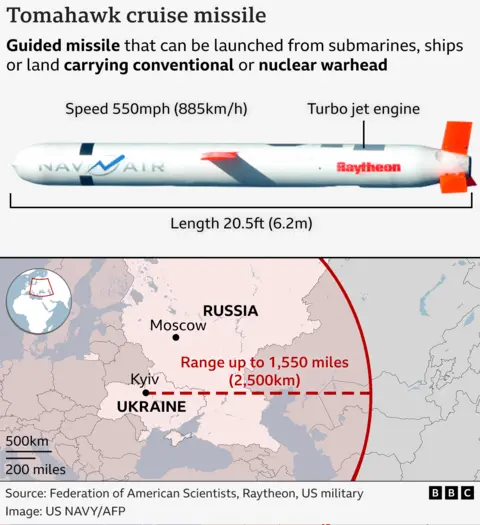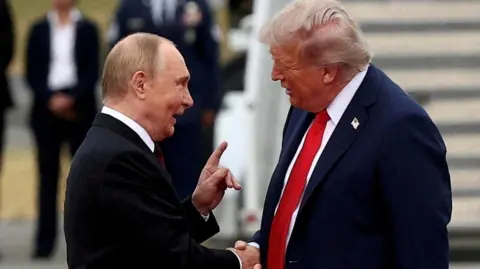
 Reuters
ReutersUkrainian President Volodymyr Zelensky will meet with US President Donald Trump in Washington on Friday, as Trump considers whether to arm Ukraine with Tomahawk missiles capable of striking deep into Russia.
Their meeting comes a day after Trump announced that “significant progress” had been made during a phone call with Russian President Vladimir Putin, in which they agreed to hold direct talks in Hungary.
Trump said the call, his first with Putin since mid-August, was “very productive,” adding that teams from Washington and Moscow would meet next week.
With Zelensky’s arrival in the United States, his third visit since January, he said that Moscow “is quick to resume dialogue as soon as it hears about Tomahawk missiles.”
Zelensky called on the United States to provide Ukraine with advanced missiles with a range of up to 2,500 kilometers (1,500 miles).
When asked earlier this week if Trump was considering giving Ukraine Tomahawk missiles, he said: “We’ll see… maybe.”
But when asked about the same possibility after his call with Putin, Trump said “we can’t deplete” the US stockpile of Tomahawk missiles, adding, “We need them too…so I don’t know what we can do about it.”
Trump wrote on his “Truth Social” platform after his call with Putin ended, saying that he and the Russian President “spent a lot of time talking about trade between Russia and the United States when the war with Ukraine ended.”
He added that “high-level advisors” from the two countries will meet in an unspecified location next week, led by Secretary of State Marco Rubio at the head of the American delegation.
Trump also said he would update Zelensky on his conversations with Putin on Friday, adding: “I think a lot of progress was made in the phone conversation today.”
He later told reporters that he expected to meet Putin in Hungary “within two weeks.”

Hours before Trump and Putin’s call, Russia launched one of its largest attacks this year on Ukraine, including 28 ballistic missiles and 320 drones, according to Ukraine’s ambassador to the United States, Olga Stefanyshina.
Stefanishina said that Russia’s launch of night strikes on Ukraine before the call “reveals Moscow’s true position toward peace.”
She added in a statement to CBS, a partner of the BBC, that: “These attacks show that Moscow’s strategy is one of terror and exhaustion. The only effective response is pressure – by imposing tougher sanctions, strengthening air defense, and providing long-range capabilities.”
Hungarian Prime Minister Viktor Orban said on Channel X that the planned Budapest meeting is “great news for the peace-loving people of the world.”
Earlier, he also said: “Peace requires patience, strength and humility. Europe must change its position. Instead of arrogance and fanning the flames of endless war, we need negotiations with Russia. Only dialogue can bring peace to our continent.”
Trump has taken a tougher stance toward Putin over the Ukraine war since his face-to-face summit in Alaska in August failed to achieve a decisive breakthrough in attempts to broker a peace deal.
The two leaders met on US soil on August 15 in a summit that the US President hoped would help convince the Russian President to enter into comprehensive peace talks to end the war in Ukraine. Russia launched its comprehensive invasion of Ukraine in February 2022.
They spoke again days later when Trump interrupted a meeting with Zelensky and European leaders to call Putin.
Since then, neither the White House nor the Kremlin have publicly confirmed any contacts between the two.
During his presidential campaign, Trump claimed that he would be able to end the war in Ukraine within days, but has since acknowledged that resolving the conflict has been more difficult than any other he has been involved in since returning to power.
Trump was seen as more sympathetic to Russia than his predecessor Joe Biden, and tense relations with Zelensky came to a head on February 28 when he and Vice President J.D. Vance berated the Ukrainian president in the Oval Office live on television.
But public relations with Zelensky have improved significantly in recent months.
In September, Trump signaled a major shift in his outlook on the conflict, saying he believed Kiev could “restore all of Ukraine to its original form,” a far cry from his public calls for Kiev to give up Russian-occupied territory.
 Reuters
ReutersIn late July, Trump set Putin a deadline of less than two weeks to agree to a ceasefire or face comprehensive sanctions, including measures against countries that still trade with Russia.
But he did not follow through on the threat after Putin agreed to meet Trump in Alaska, which the US president hailed as a major diplomatic success at the time, even though it did not produce any tangible result.
Earlier on Thursday, the Indian Foreign Ministry questioned a claim made by Trump the previous day in which he said that Indian Prime Minister Narendra Modi had agreed to stop purchasing Russian oil.
An Indian government spokesman said he was “not aware of any conversation between the two leaders” that took place the previous day, after Trump said Modi had assured him that the purchases would stop “within a short period of time.”
The United States has put pressure on countries – especially India, China and NATO member states – to stop purchasing Russian energy in an attempt to increase economic pressure on the Kremlin. Zelensky also echoed these calls repeatedly.

